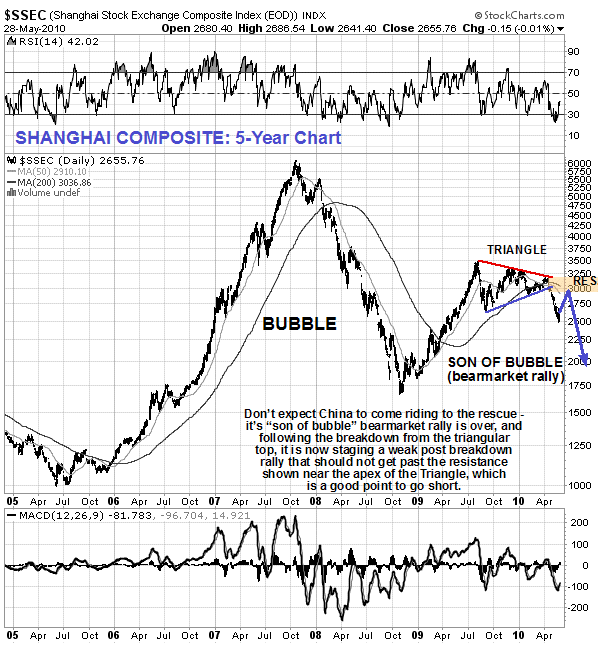At first sight the gold chart continues to look bullish. It has continued to make new highs in the recent past, and there are still only faint glimmerings of possible weakness. Actually it is in position to �go parabolic� - but how likely is this if everything else caves in? - the answer is it isn�t, so we must look for alternative more conservative scenarios that accord more with what we are seeing elsewhere. The 11-year chart shows the gold bull market in its entirety from the time of the �Brown Bottom�, when Gordon Brown famously sold half of Britain�s gold reserves at the bottom of the market, generously ending a 20-year bear market in gold, for which he is presumed to have been rewarded with the promise of becoming the Prime Minister of Britain.
The positive thing about this chart is that it shows that gold could fall as far as the $900 area, or even the $800 area, without violating long-term uptrend support lines and ending the bullmarket. Given that the inevitable hyperinflation in the US is not expected to kick in for a while, perhaps 2 years, maybe 3, what could happen is that gold drops back to test either of the lower supporting channel lines shown on this chart, against the background of plunging commodity and stock markets, as in 2008, before turning higher and accelerating away to the upside as the expected hyperinflation approaches.

For anyone entertaining the notion that China will be the engine of growth that hauls the rest of the world out of the mire, the chart above for the Shanghai Composite index must be disconcerting. China�s post bubble bearmarket rally had already run its course by the middle of last year, after which it topped out with a triangular pattern, from which it recently broke down decisively. A final rally back up towards the underside of the Triangle is likely in coming weeks, which is expected to provide a last opportunity to get out of Chinese stocks and short the market.
The best course of action for investors and speculators going forward should be obvious from what is set out above. If you concur with the arguments presented here then you have the choice of either selling out most holdings into whatever strength we see in coming days or weeks, before the markets turn lower again, which will get you the better prices, or of waiting for the patterns to break down, which will make it more certain that we are in for a heavy decline. Note that at this point it is not clear how long the broad market will take to complete the Right Shoulder of its Head-and-Shoulders top - it could take as long as a month or two, but may take much less. Another point is that the Right Shoulder of the pattern is likely to top out at a level lower than that of the Left.
We are going to go into full defensive mode, which means cash, protection of any open long positions with Puts, and the use of conservative bear plays primarily to preserve capital but also as a means to profit from the expected heavy declines, for given that markets tend to drop twice as fast as they go up, because panic is a more powerful emotion than greed, as made plain by the events of 2008, there is no reason why we should sit on our hands and pass up the opportunities that will be presented by the general misfortune. We will be looking at a range of bear plays whose chief purpose is to safeguard capital, but also have the capacity to make substantial gains, over the next several days on the site.
Finally, we should note that although the markets appear to be drawing close to another 2008 style meltdown, there will be some big differences between the collapse in 2008 and the one that is looming. In the first place it could be considerably worse, as none of the underlying structural distortions and problems that led to the collapse in 2008 have been squarely addressed and dealt with - the problems have simply been swept under the carpet by the application of massive doses of additional liquidity and the further ramping of debt. Secondly we are not too talking about companies that are too big to fail needed to be bailed out at taxpayer�s expense, this time round we are looking at entire countries going bust - politely referred to as �sovereign defaults�, and unless other countries step up to the plate to bail out those heading for the rocks, they will have to bail themselves out - which means either devaluation of their currencies or self-monetization requiring a massive ramping of the money supply which will feed through into rampant inflation or hyperinflation.

